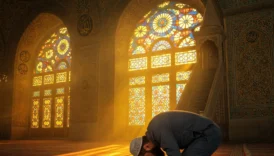How To Perform Eid Prayer
Experience the collective joy of Eid through a special prayer. Embrace this act of worship with purity, unity, and gratitude. Discover the significance, method, and essential elements to make your Eid prayer spiritually fulfilling.
- How To Perform Eid Prayer
- What Is Eid Prayer
- The Ruling And Importance Of Eid Prayer
- Eid Prayer Time
- Preparation For Eid Prayer
- Eid Takbirs
- How To Perform Eid Prayer
- Additional Takbīrs In The Second Rak’ah
- Khutbah After The Prayer
- Short Duas For Eid Prayer
- The Virtues Of Eid Days
- Other Recommended Acts On Eid Day
- Common Mistakes
- Women’s Participation In Eid Prayer
- Last Word
- References
What Is Eid Prayer
Eid Prayer is a special two-rak’ah congregational act of worship performed on the mornings of Eid al-Fitr and Eid al-Adha. It symbolizes the collective joy and gratitude of the Muslim community, uniting believers in celebration and reverence.
The Ruling And Importance Of Eid Prayer
Scholars have different opinions on the ruling of Eid Prayer. According to the Hanafi School, it is wājib (obligatory), whereas the Shāfiʿī and Mālikī Schools consider it a strongly emphasized sunnah (sunnah mu’akkadah). What remains undisputed is the Messenger of Allah (peace be upon him) performed this prayer consistently, and his Companions followed suit. Eid Prayer fosters unity, gratitude, and mutual joy among believers, serving as a highlight of these festive days.
Eid Prayer Time
Eid Prayer begins roughly 45 minutes after sunrise or once the sun has risen to the height of a spear above the horizon. For Eid al-Fitr, performing it slightly later is recommended, allowing time to distribute the zakāt al-fitr beforehand. For Eid al-Adha, it is generally performed earlier so people can proceed to sacrifice (qurbān) promptly.
Preparation For Eid Prayer
Observing certain practices before Eid Prayer enhances its spiritual impact and augments the celebratory atmosphere:
• Performing ghusl (ritual bathing) on the Eid morning • Using miswāk or brushing the teeth • Wearing clean, presentable clothes • For Eid al-Fitr, eating a sweet snack (often dates) before going to the mosque • For Eid al-Adha, if one intends to sacrifice, it is preferable not to eat before the prayer
Traditions report that the Prophet (peace be upon him) would bathe, wear his best garments, and apply pleasant fragrances on Eid mornings (Abū Dāwūd and Tirmidhī). These acts are revered as established prophetic customs.
Eid Takbirs
The recitation of takbīrs underscores the joy and gratitude of Eid. Variations exist, but commonly, the takbīrs are as follows:
Allāhu akbar Allāhu akbar Lā ilāha illallāhu wallāhu akbar Allāhu akbar wa lillāhi’l-hamd
Transliteration: Allāhu akbar Allāhu akbar Lā ilāha illallāhu wallāhu akbar Allāhu akbar wa lillāhi’l-hamd
Meaning: Allah is the Greatest. Allah is the Greatest. There is no deity except Him; He is truly the Greatest. All praise belongs to Allah.
In the Hanafi School, the recommended practice is to start these takbīrs from the evening before the Eid Prayer and continue until the prayer begins. In Eid al-Adha, it is considered wājib to recite the takbīrs after the farḍ prayers from the Fajr of ʿArafah day until the ʿAṣr prayer on the fourth day of Eid.
How To Perform Eid Prayer
Eid Prayer consists of two rak’ahs, performed in congregation without an adhān or iqāmah. The step-by-step procedure in the Hanafi School is as follows:
- Intention: “I intend to perform the Eid Prayer for the sake of Allah, following the present imām.”
- Opening Takbīr: Raise your hands to your ears, say “Allāhu akbar,” and place them to your sides.
- Additional Takbīrs (First Rak’ah): Then, repeat “Allāhu akbar” three times, raising your hands with each takbīr and letting them rest at your sides. On the fourth takbīr, fold your hands over your chest as in normal prayer.
- Recitation Of Sūrat Al-Fātiḥah And Another Sūrah: The imām recites Sūrat al-Fātiḥah and a short portion or sūrah from the Qur’ān. The congregation remains silent.
- Bowing (Rukūʿ) And Prostrations (Sujūd): Continue as in standard prayers, completing one rukūʿ and two prostrations.
Additional Takbīrs In The Second Rak’ah
- Standing Up: Upon rising for the second rak’ah, the imām recites Sūrat al-Fātiḥah, followed by another short sūrah.
- Additional Takbīrs: Before going to rukūʿ, repeat “Allāhu akbar” three times again, raising your hands each time and letting them rest at your sides. On the fourth “Allāhu akbar,” proceed to rukūʿ.
- Completion And Salām: Perform the final prostrations, then sit for tashahhud, ṣalawāt (blessings upon the Prophet), and other supplications. Conclude with salām to both sides.
Khutbah After The Prayer
Following the Eid Prayer, the imām delivers the khuṭbah (sermon). This sermon includes reminders about the virtues of the day, such as paying the zakāt al-fiṭr on Eid al-Fitr or performing the sacrifice (qurbān) on Eid al-Adha. Once the khutbah finishes, the congregation offers a communal duʿā’ and disperses.
Short Duas For Eid Prayer
Offering duʿā’ before or after the Eid Prayer is commendable. For instance, you may reflect on a short sūrah or hadith:
Qur’an Verse
اِنَّا اَعْطَيْنَاكَ الْكَوْثَرَ
Transliteration:
Innā aʿṭaynāka’l-kawthar
Meaning: “Indeed, We have granted you al-Kawthar.” (Sūrat al-Kawthar, 1)
Hadith
Arabic:
«مَنْ صَامَ رَمَضَانَ إِيمَانًا وَاحْتِسَابًا غُفِرَ لَهُ مَا تَقَدَّمَ مِنْ ذَنْبِهِ»
Transliteration:
Man ṣāma ramaḍāna īmānan wa iḥtisāban ghufira lahu mā taqaddama min dhanbih.
Meaning: “Whoever fasts in Ramaḍān with faith and seeking its reward (from Allah) will have his past sins forgiven.” (Bukhārī, Ṣawm, 6)
The Virtues Of Eid Days
Eid is not merely a physical celebration but also a spiritual renewal. It is a time for gratitude, charity, visiting relatives, and strengthening the bonds of brotherhood. Eid al-Adha commemorates the unwavering devotion of Prophet Ibrāhīm (peace be upon him) and Prophet Ismāʿīl (peace be upon him), while Eid al-Fitr highlights the spiritual rewards of fasting Ramaḍān.
Other Recommended Acts On Eid Day
• Charity And Support: Share your joy with the less fortunate. Offer donations or gifts, specifically zakāt al-fiṭr for Eid al-Fitr and the sacrificial meat for Eid al-Adha. • Visits: Meeting relatives, friends, and neighbors fosters a sense of unity and love. • Optional Worship: Beyond the Eid Prayer, you may offer additional nāfilah (supererogatory) prayers, recite Qur’ān, and engage in remembrance (dhikr) and supplications. • Eid Greetings: Greeting fellow Muslims with warmth, seeking forgiveness, and strengthening ties embodies the spirit of these blessed days.
Common Mistakes
- Neglecting The Eid Prayer: Some individuals treat Eid morning merely as a holiday, oversleeping or not prioritizing the prayer.
- Forgetting The Takbīrs: Eid takbīrs, especially during Eid al-Adha, are a fundamental expression of gratitude.
- Leaving Immediately After The Prayer: The khutbah is an essential part of Eid observance, offering guidance and reminders.
Women’s Participation In Eid Prayer
During the Prophet’s lifetime, women were encouraged to attend the Eid Prayer (Bukhārī, ʿĪdayn, 20; Muslim, ʿĪdayn, 12). Even those who were not praying, such as women in menstruation, were allowed to listen to the khuṭbah from a designated area. This inclusion embraces the communal spirit of Eid.
Last Word
Eid Prayer is a beautiful manifestation of brotherhood, gratitude, and renewed commitment to faith. By gathering in congregation, believers shoulder one another’s concerns and amplify shared joys. This moment of unity and supplication fosters deeper bonds within the ummah and underscores the mercy and blessings inherent in the Islamic tradition.
References
• Bukhārī, Ṣaḥīḥ al-Bukhārī • Muslim, Ṣaḥīḥ Muslim • Abū Dāwūd, Sunan • Tirmidhī, Sunan • Mālik, Muwaṭṭaʾ • Ibn Mājah, Sunan • ʿAbd al-Raḥmān al-Jazīrī, al-Fiqh ʿalā al-Madhāhib al-Arbaʿah • Ömer Nasuhi Bilmen, Büyük İslâm İlmihali





